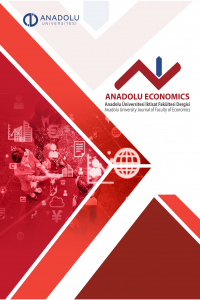Türkiye'nin Bölgesel Pazarlara İhracatı ve Ekonomik Büyüme İlişkisi (1998Q1 – 2019Q4)
24 Ocak 1980 kararlarıyla Türkiye ekonomisi dışa açık ve ihracata dayalı bir sanayileşme stratejisi benimsemiştir. Bu kararların ardından Türkiye'nin hem ihraç ettiği ürünlerde hem de ihracat pazarlarında önemli gelişmeler yaşanmıştır. Örneğin, ağırlıklı olarak Avrupa Birliği ülkelerine yapılan ihracat yapısı son zamanlarda Ortadoğu ve Asya ülkeleri lehine değişmiştir. Bu nedenle, Türkiye'nin bölgesel ihracatı ile ekonomik büyümesi arasındaki ilişkiyi araştırmak önem kazanmıştır.
Bu çalışmanın amacı, Toda-Yamamoto nedensellik analizi ile Türkiye'nin bölgesel ihracatı ile ekonomik büyümesi arasındaki ilişkiyi ortaya koymaktır. Çalışmada, Toda-Yamamoto nedensellik analizi, Türkiye İstatistik Kurumu'ndan (TÜİK) 1998Q1 ile 2019Q4 arasında elde edilen üçer aylık veriler kullanılarak gerçekleştirilecektir. Çalışmanın bulgularına göre, Türkiye'nin Avrupa ülkelerine ihracatı ile ekonomik büyümesi arasında çift yönlü nedensellik mevcuttur. Ayrıca Afrika ülkelerine yapılan ihracattan Türkiye’nin ekonomik büyümesine doğru tek yönlü nedensellik söz konusudur. Bununla birlikte Türkiye’nin ekonomik büyümesinden Asya ve Ortadoğu ülkelerine yapılan ihracata doğru tek yönlü nedensellik bulunmuştur.
Anahtar Kelimeler:
İhracat, Ekonomik büyüme, Nedensellik analizi
Relationship between Turkey's Export to Regional Markets and Economic Growth (1998Q1 - 2019Q4)
With the decisions of January 24, 1980, the Turkish economy adopted an open and export-based industrialization strategy. After these decisions, significant developments have been experienced by Turkey both in the exported products and export markets. For example, the export structure to the heavily-weighted European Union countries has recently changed in favour of the Middle East and Asian countries. Therefore, it is important to investigate the relationship between Turkey's regional exports and economic growth.
The aim of this study is to reveal the relationship between Turkey's regional exports and economic growth through causality analysis. In the study, Toda-Yamamoto causality analysis will be carried out using the quarterly data obtained from the Turkish Statistical Institute (TUIK) from 1998Q1 to 2019Q4. According to findings of the study, there is bidirectional causality between Turkey’s exports to European countries and its economic growth. Also, there is a one-way causality from exports to African countries to economic growth. However, it has been found unidirectional causality in Turkey's exports of the Asia and Middle East countries to the economic growth.
Keywords:
Export, Economic growth, Causality analysis,
___
Abosedra, S., Tang, C.F. (2018). Are Exports a Reliable Source of Economic Growth in MENA Countries? New Evidence from the Rolling Granger Causality Method. Empirical Economics, 56 (3), 831-841.Aditya, A., Acharyya, R. (2013). Export Diversification, Composition, and Economic Growth: Evidence from Cross-Country Analysis. The Journal of International Trade & Economic Development, 22(7), 959-992.
Ajmi, A. N., Aye, G. C., Balcılar, M., & Gupta, R. (2015). Causality between Exports and Economic Growth in South Africa: Evidence From Linear and Nonlinear Tests. The Journal of Developing Areas, 49(2), 163-181.
Bülbül, S. E., Demiral, A. (2016). Türkiye Ekonomisinde Ekonomik Büyüme, İhracat ve Eximbank Kredileri Arasındaki Nedensellik İlişkisi: 2002-2015. Öneri Dergisi, 12(46), 21-40.
Feder, G. (1982). On Exports and Economic Growth. Journal of Development Economics, 12(1-2), 59-73.
Ferreira, G. F., & Harrison, R. W. (2012). From Coffee Beans to Microchips: Export Diversification and Economic Growth in Costa Rica. Journal of Agricultural and Applied Economics, 44(04), 517-531.
Furuoka, F. (2018). Exports and Economic Growth in Sub-Saharan Africa: New Insights from Innovative Econometric Methods. The Journal of International Trade & Economic Development, 27(7), 830-855.
Gerni, C., Değer, M. K., Emsen, Ö. S., & Gencer, A. H. (2013). Relationship between Import-Led Exports and Economic Growth: The Experience of Turkey (1980-2008). Social Sciences Research Journal, 2(2), 15-36.
Goh, S. K., Sam, C. Y., & McNown, R. (2017). Re-examining Foreign Direct Investment, Exports, and Economic Growth in Asian Economies Using a Bootstrap ARDL Test for Cointegration. Journal of Asian Economics, 51, 12-22.
Karagöz, M., Şen, A. (2005). Exports and Economic Growth of Turkey: Co-integration and Error-Correction Analysis. Elektronik Sosyal Bilimler Dergisi, 4(13), 1-15.
Khan, M., Salam, A. & Batool, A. (2015). Nexus between Agriculture Raw Materıal Exports, Trade Openness and Economıc Growth of Pakistan. Journal of Agricultural Research, 53(4), 581-589.
Misztal, P. (2011). Export Diversification and Economic Growth in European Union Member States. Acta Oeconomia, 10(2), 55-64.
Mosikari, T. J., Charlotte Senosi, M., & Eita, J. H. (2016). Manufactured Exports and Economic Growth in SADC Region: A Panel Cointegration Approach. Acta Universitatis Danubius. Œconomica, 12(5), 266-278.
Toda, H. Y., Yamamoto, T. (1995). Statistical Inference in Vector Autoregressions with Possibly Integrated Processes. Journal of Econometrics, 66(1), 225-250.
Tsen, W. H. (2010). Exports, Domestic Demand, and Economic Growth in China: Granger Causality Analysis. Review of Development Economics, 14(3), 625-639.
Tuncer, İ. (2002). Türkiye’de İhracat İthalat ve Büyüme: Toda Yamamoto Yöntemiyle Granger Nedensellik Analizleri (1980-2000). Çukurova Üniversitesi Sosyal Bilimler Enstitüsü Dergisi, 9(9), 89-107.
Vianna, A. C. (2016). The Impact of Exports to China on Latin American Growth. Journal of Asian Economics, 47, 58-66.
Vogiatzoglou, K., Nguyen, P. N. T. (2016). Economic Openness and Economic Growth: A Cointegration Analysis for ASEAN-5 Countries. The European Journal of Applied Economics, 13(2), 10-20.
- Yayın Aralığı: Yılda 2 Sayı
- Başlangıç: 2019
- Yayıncı: Anadolu Üniversitesi
Sayıdaki Diğer Makaleler
Türkiye'nin Bölgesel Pazarlara İhracatı ve Ekonomik Büyüme İlişkisi (1998Q1 – 2019Q4)
Türkiye'nin Bölgesel Pazarlara İhracatı ve Ekonomik Büyüme İlişkisi (1998Q1 – 2019Q4)
Küresel Yönetişimde Devletlerin Rolü: Japonya Örneği
Şebnem TOSUNOĞLU, Süleyman KASAL
Şebnem TOSUNOĞLU, Süleyman KASAL
Gelişmekte Olan Ülkelerde Dış Borçlanmanın İktisadi Kalkınmaya Etkisi
Piyasa Başarısızlıklarından Dışsallıklar ve Çözüm Yollarına İlişkin Değerlendirmeler
